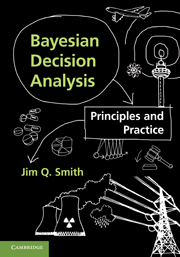8 - Graphs, decisions and causality
from Part II - Multidimensional Decision Modelling
Published online by Cambridge University Press: 05 June 2012
Summary
Influence diagrams
Introduction
In Chapter 2 we discussed the decision tree which extended the semantics of an event tree so that the full decision problem could be expressed. In this section we discuss how a similar extension can be made to the semantics of a BN. This diagram I is called an influence diagram (ID) and is very useful for representing a decision problem and for providing a framework to discover optimal decision rules.
An influence diagram cannot be effectively used to represent all decision problems since they depend to a significant degree on a certain type of symmetry being present. However the conditions in which they are a useful tool are met quite often in practice and Gomez (2004) catalogues over 250 documented practical applications of the framework before 2003.
Unlike the decision tree whose topology represents relationships between events and particular decisions taken, the influence diagram represents the existence of relationships between random variables – represented by ∘ vertices, decision spaces – denoted by □ vertices and a utility variable – denoted by a ◊ vertex. When appropriate they have many advantages over the decision tree. First they are usually much simpler to draw. Second like the BN they represent qualitative dependences exhibited by a problem and so the structure they express can be quite general, transparent and easy to elicit early in an analysis. Third we have seen how useful and intrinsic the conditional independence relationships between variables can be and the influence diagram expresses these directly through its topology.
Information
- Type
- Chapter
- Information
- Bayesian Decision AnalysisPrinciples and Practice, pp. 248 - 281Publisher: Cambridge University PressPrint publication year: 2010
